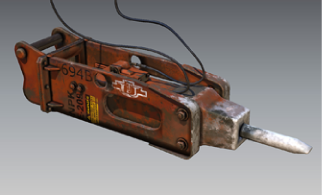The paint feature lets you apply digital paint to your high resolution 3D models in Mudbox. You simply select a paint brush, create a layer to paint on, and begin painting on your model in the 3D View.

Two paint modes are available:
When you paint on a model in Mudbox you create one or more 2D bitmap images that are positioned on top of the base shading material. The accurate positioning of your painted images on the 3D model is based on the location of the UV texture coordinates (UVs) for the model, and the image positioning process is referred to as mapping. UV mapping correlates the pixel locations on the 2D image you paint to the surface of the 3D model.
You can tell if your model has UVs by switching to the UV View. The UV View is also useful for evaluating how your painted image looks in relation to the UV texture coordinates.
When you paint on a model in Mudbox, the paint is applied to a paint layer. Paint layers let you keep track of the 2D bitmap image(s) you create as you paint. Layers are similar to transparent pieces of acetate that let you separate paint between one layer and another.
You can paint different types of information on paint layers. For example, the default paint layer is diffuse color. This paints the color you specify into a diffuse channel that appears as a component of the object’s material. You can also paint gloss, specular, reflection, and bump values directly onto your models using the 3D paint tools using layers. For more information on the material properties you can paint, see Create New Paint Layer window.
A layer is fully transparent until you paint on it. Areas of the paint layer that do not get painted allow the underlying material or underlying paint layers to show through.
You can add more paint layers as you need them. When a new layer is created it is positioned above the currently selected one. That is, multiple paint layers are stacked on top of each other to produce the final composite result. For more information, see Create a new paint layer.
You can specify paint layers with different resolutions and bit depths on the same model (unlike many other paint applications that require one consistent canvas size). This is extremely useful if you need to be mindful of the amount of texture memory a material uses.
You can paint across multiple UV tiles (provided the UVs for your model are laid out in this way) and take advantage of the increased texture resolution this technique can provide. Mudbox automatically manages the layers and associated images for each UV tile. For more information, see Paint across multiple UV tiles.
You can duplicate, hide or show, delete, and export paint layers. You can import images into a layer and edit the images using the paint tools. The order of layers and their opacity/transparency values produce the model’s net coloring. For more information, see Duplicate a paint layer and Hide or show a paint layer.
You can re-order paint layers by dragging and dropping a layer between two others. Dragging a layer to a different paint layer channel type can be done to change how it is rendered on the model. For more information, see Change the order of paint layers.
You can merge paint layers to reduce the number of layers and reduce the amount of texture memory used by the file. For more information, see Merge paint layers.
You can export paint layers to other image editing applications such as Adobe Photoshop and transfer your work back and forth between the two applications. For more information, see Use Mudbox and Photoshop together.

The bitmap images that you paint are automatically saved with your Mudbox file (.mud) in a separate sub-directory at the same location as the .mud file. This image file can be used with other 3D rendering applications such as mentalRay or Renderman. For more information, see Save your work.
Alternately, you can export a selected layer and save your painted images in any of the image formats that Mudbox supports. For more information, see Image file formats.
While image resolution (the number of pixels in both the horizontal and vertical axes) is key in determining the detail and definition in the images you create on the paint layers in Mudbox, the color bit depth of a paint layer is also a critical component to consider, depending on your particular production pipeline and file output requirements.
Color bit depth refers to the number of colors that can be displayed within an image. The higher the bit depth (16, 32), the larger the color palette that can be used to represent the image. This provides the possibility of representing a much richer (and also subtle) range of shading in images compared to those that use a lower bit depth (8 bit).
Images with higher color bit depths retain their characteristics better when edited compared to lower bit depth images in terms of the ability to adjust their brightness, color, and contrast which can be particularly helpful when working in a production environment and the image criteria must respond to changes in the direction of a design.
Painting using very low strength brushes also produces better results when the paint layer is of a higher bit depth (16 bits floating point) in comparison to paint layers that are 8 bits per channel.
For a list of supported file formats and bit depths, see Paint file formats.